Adopted in 2021, the New Development Model (NMD) sets a clear ambition for energy transition in Morocco: to make the country a regional leader in green and low-carbon energy by 2035. Three years after its launch, an independent evaluation conducted by the IMAL Initiative for Climate and Development assesses the progress made and the persistent challenges.
Notable progress, but worrying delays
The NMD identifies six strategic reforms necessary for the energy transition:
- Establishment of an independent and credible regulator to ensure effective governance of the sector.
- Transparent and competitive pricing policy, clarifying the roles of stakeholders.
- Restructuring of ONEE to modernize the electricity transmission network.
- Development of decentralized production to ensure more accessible and competitive electricity.
- Liberalization of access to natural gas for industry.
- Positioning Morocco as a regional platform for energy exchanges and R&D innovation.
However, the gap between ambitions and concrete achievements remains significant. Obstacles still hinder the deployment of renewable energies, despite progress on some key projects.
Economic and industrial risks at stake
The delay in the energy transition could have serious consequences on:
- Public finances, with prolonged dependence on fossil fuels weighing on the trade deficit and foreign currency reserves.
- Industrial competitiveness, particularly in light of new European Union requirements regarding the reduction of the carbon footprint of imported products.
A necessary paradigm shift
The IMAL evaluation highlights the urgency of a renewed approach to accelerate the energy transition. Five areas for improvement are recommended:
- Politicize the energy transition: it should no longer be solely a technical issue, but also a strategic and economic challenge.
- Shift to a solution-oriented approach, clarifying the mandates and responsibilities of sector stakeholders.
- Enhance transparency by making data and decisions accessible to stakeholders.
- Adopt a flexible and adaptive approach that can respond to market changes.
- Keep the ultimate goal in sight, aligning political and regulatory decisions with Morocco’s energy leadership ambition.
Three priority areas for the next five years
The evaluation highlights three priority areas to intensify efforts:
1️⃣ Unleash the potential of decentralized energy
- Develop smart infrastructures to integrate renewable energies.
- Lift access restrictions to the grid for photovoltaic installations.
2️⃣ Review long-term power purchase agreements
- Negotiate the gradual phase-out of coal-fired power plants, limiting their economic impact.
- Mobilize international funding for a fair energy transition.
3️⃣ Make Morocco a platform for green electricity exchange
- Strengthen energy interconnections with Europe and West Africa.
- Harmonize the electricity market with international standards.
Conclusion
Morocco has major assets to succeed in its energy transition. But without an acceleration of reforms, it risks losing its lead and seeing its competitiveness affected. The implementation of the NMD recommendations must therefore be strengthened, with increased coordination between public and private actors.


